In 1908, as the world’s attention focused on the Olympic Games in London, Britain had decided again not to allow Ireland to field its own team, imperiously stating, “Ireland is not a nation.” All Irish athletes would have to compete as members of the British team.
The policy had worked well for Britain in the 1906 Intercalated Olympics in Athens, where Irish athletes won most of Britain’s medals in track and field.
Having to represent Britain infuriated the Irish athletes. One of them, Peter O’Connor, rushed to the Olympic flagpole after winning the hop, step and jump, and pulled down the Union Jack, which had been raised in honor of his victory. In its place he flew a green flag for Ireland.
Despite O’Connor’s act of defiance, Britain was now out to garner more victories by such “British” athletes in the 1908 Olympics in London. Several Irish champions refused to compete rather than be used again by the British. Watching the latest British suppression of Irish nationalism put Irish Americans at a fever pitch.
On July 13, King Edward VII declared the Fourth Olympiad opened. The stadium displayed the flags of all the competing nations, except that of the United States. Where was the American flag? The British said they had been unable to find one. Equally insulting, the American team was assigned a marching position just in front of the “British Colonies,” who, in turn, were followed by the United Kingdom. The symbolism could not have been lost on anyone present.
As the music of Grenadier Guards filled the stadium, King Edward settled into the royal box with Queen Alexandra and Princess Victoria at his side. At the Bugler’s signal, the gate leading to the athletes’ quarters was flung open and the parade of national teams began. One by one, they marched by the royal box and dipped their flags to the King of England. It was a glorious moment for the host nation. Even the hard rain that had drenched the stadium earlier in the day had stopped. God seemed to be smiling on the Empire.
Then came the Americans, including the world-record hammer thrower and New York City cop, Matthew J. McGrath. When they approached the royal box, the County Tipperary-born McGrath, a six-foot, two-inch, 245-pound human bull of a man, stepped beside the team’s flag bearer and is rumored to have said, “Dip that banner and you’re in hospital tonight.” Old Glory went unbowed past the King of England.
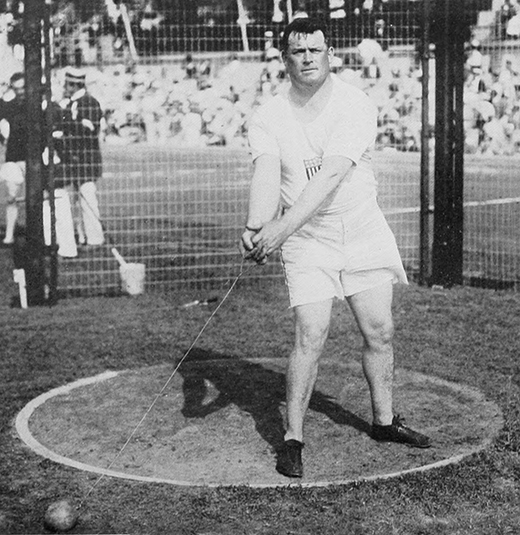
The English were left in shock. London newspapers lashed the Americans with the severest criticism they could muster and called for an apology. Veteran Olympian and world-record discus thrower Martin J. Sheridan, another New York City cop, spoke of “Mighty Matt” McGrath and the other American team members when he answered the English by pointing to the flag and saying, “This flag dips to no earthly king.” The precedent had been set. To this day the United States does not dip its flag at Olympic ceremonies.
Preliminary heats were run for the 1,500-meter race – the “metric mile” – later on opening day. Controversy continued. The British held the drawings for heat assignments in private. The Americans suspected conspiracy. The “luck of the draw” consistently left America’s best runners bunched together in one or two heats where they eliminated each other. James E. Sullivan, the commissioner representing the United States, commented: “It is extraordinary bad luck or the manner in which the drawings have been made that has resulted in such unfavorable conditions for the Americans. We have tried to find out how the drawings are conducted, but have not been able to get anything from the officials except the reply, ‘The drawings are made in the usual way.’” Despite Sullivan’s protestations, the British continued to hold the drawings in “the usual way” throughout the games.
The first heat of the 1,500-meters went to J.P. Sullivan of the Irish American Athletic Club of New York City. Mel Sheppard, also of the Irish American club, took the second heat. However, several other Americans had also run the first two heats and thus were eliminated, while Englishmen had been nicely distributed in heats three through eight. The next day Sheppard and Sullivan found themselves facing five Englishmen and a Canadian. Two of the Englishmen – world-record holder Harold Wilson, a tiny chap at 5’ 4” and 115 pounds, and middle-distance runner Norman Hallows – were considered the favorites to win. Mike Murphy, the coach of the American team, stepped up to Sheppard and said: “Mel, you might as well stay in the stands. You don’t have a chance.” Murphy then winked at Sullivan and walked off. Sheppard ran his best when angry and Murphy had left him steaming.
The Englishmen ran a tactical race and, for a time, it looked as if they might shut out the Americans. But Sheppard, still in a rage, put on a tremendous finishing kick and won by a couple of yards in 4:03.4, setting an Olympic record. Ironically, Sheppard, who wanted to be a cop, had been rejected only months earlier by the New York Police Department because of what the department’s medical examiners called a bad heart.
The Irish American Athletic Club and the United States had a gold medal, and now the English were the ones steaming.
Meanwhile, the final in the hammer throw was being held. The American powerhouses Matt McGrath of the New York Athletic Club and his teammate John J. Flanagan of the Irish American Athletic Club were expected to dominate. McGrath was the world-record holder and the County Limerick-born Flanagan the reigning Olympic champion. Flanagan, like McGrath, was a New York City cop. The lead seesawed back and forth, with first McGrath, despite an injured leg, and then Flanagan breaking the Olympic record. Flanagan ultimately took the gold medal and McGrath the silver. The bronze went to County Cork-born Canadian Cornelius Walsh. The awards ceremony must have been especially galling to the English, having to watch their king present the Olympic medals to a Flanagan, a McGrath, and a Walsh. When Matt McGrath received his medal, he was said to have responded to King Edward’s compliments in “a brogue two sizes wider” than normal.
Two days later, the Irishmen from America were at it again. They swept the discus final, with County Mayo-born Martin J. Sheridan taking the gold medal. Sheridan would also take the gold in the “Greek style” discus throw, and win the bronze in the standing broad jump. In three Olympic games, the tall, lanky Sheridan won five gold medals, three silver, and one bronze.
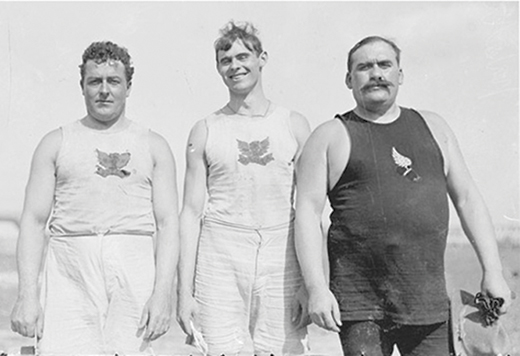
Although he won the shot put in the 1906 Olympics, Sheridan didn’t put the 16-pound ball in London. In his absence, Ralph Rose of San Francisco won, and Denis Horgan of Ireland took second. The County Cork-born Horgan was a 37-year-old New York City cop who retired from the force after being severely injured while breaking up a brawl in 1907. Considering his injuries and his age, few thought he would ever compete again, let alone win an Olympic medal. However, his silver medal was chalked up for Britain.
While American Irishmen were bringing home the gold in the track-and-field events, which Americans considered the real Olympics, Britain was racking up the medals in cycling, shooting, polo, walking, and tennis. In addition, the British were using their own unique scoring system, which would practically ensure them an overall victory even if American dominance continued in track and field. U.S. commissioner Sullivan formally protested the special scoring system but to no avail.
The British qualified two runners, Theodore Just and Ian Fairbairn-Crawford, for the 800-meter final. They decided that Fairbairn-Crawford would set a blistering pace and sacrifice himself in an effort to run the kick out of American finalist Mel Sheppard. At the sound of the starter’s gun Fairbairn-Crawford raced into the lead and almost sprinted the first 200 yards. Sheppard did not take the bait. He ran at his own pace, and with 300 yards to go began a withering kick that destroyed the field. Fairbairn-Crawford dropped out and Just finished well back in the pack. Sheppard’s winning time of 1:52.8 broke not only the Olympic record but also the world record.
The same day another member of the Irish American Athletic Club was winning the high jump. Harry F. Porter easily cleared 6’3” to set an Olympic record and then had the bar raised to 6’6” in an effort to break the world record of 6’5⅝”, set by Irish-born Michael F. Sweeney in New York City in 1895. Porter just brushed the bar off on one of his three attempts. Second place went to the Irish champion Cornelius Leahy of County Limerick, but his points went to Britain.
The next day Britain had something to cheer about when Reginald E. Walker of South Africa won the 100-meter race, but Francis C. Irons of the Chicago Athletic Club won the broad jump and Daniel J. Kelly of the Irish American Athletic Club took second. Irons’ leap stretched 24’ 6½”, an amazing distance for a man who stood just 5’5”. The mark bettered the old Olympic record by nearly a half-foot but fell that same distance shy of breaking Peter O’Connor’s world record. Then in the 400-meter hurdles, New York City cop Charles J. Bacon of the Irish American Athletic Club not only won but also set a world record of 55.0 seconds.
The score in the track-and-field events at this point stood: United States – 75; United Kingdom – 56; Sweden – 12; Greece – 6; and some nine other countries with five points or fewer. Britain was leading in total overall points, but because Britain had introduced several new events (many of which she alone competed in) and was using her own unique scoring system, most observers thought the score meaningless. Real attention was focused on the track-and-field events.
British newspapers were daily publishing increasingly virulent attacks on the Americans. U.S. team coach Mike Murphy was worried. The day after Bacon’s world-record win in the 400-meter hurdles, the final in the 400-meters was held. The four finalists included three Americans: J.C. Carpenter, W.C. Robbins, and John Taylor, and one Englishman: Wyndham Halswelle. Murphy assembled the American runners and warned them the British were looking for any excuse to disqualify the Americans.
The atmosphere was tense when the starter’s pistol cracked. Taylor got off slowly and the 400-meter quickly became a three-man race with Robbins in the lead by a yard, followed by Carpenter and Halswelle. Coming out of the final turn, Carpenter drifted wide but at the same time began a devastating kick, which carried him past Robbins to victory. Robbins held on to second and Halswelle, the Englishman, came in third. Or so it seemed. British officials began yelling foul and claimed that when Carpenter drifted wide coming out of the final turn, he had interfered with Halswelle.
After a short delay, British officials declared the race void. As the New York Times reported: “A great British cheer broke out, and continued for several minutes, men who could not under any circumstances have seen the incident crying ‘Foul!’ louder than those sitting opposite the spot where the alleged foul was said to have taken place, and who, seeing Halswelle taking a wide turn, thought it a mistake in judgment, as he has [sic] lots of room to pass Carpenter on either side.”
Matthew P. Halpin, the manager of the American team, immediately entered a protest on behalf of Carpenter. A special committee of British officials assembled in private to decide the issue. They took testimony from the judges who had first alleged that a foul had occurred, and from Halswelle, but refused to allow American officials or Carpenter himself to attend the meeting or even to submit statements. Their decision was predictable. The race was declared void and would be rerun, and Carpenter was disqualified. U.S. commissioner James Sullivan said, “Never in my life, and I have been attending athletic meetings for 31 years, have I witnessed a scene that struck me as being so unsportsmanlike and unfair as that in which the officials participated… The race was as fair as any race run.”
The Times of London didn’t think so. In what it claimed was “a fair and impartial account” of the race, the Times said Carpenter ran “diagonally” across the track and “elbowed” Halswelle. Moreover, this was a “definite and carefully thought-out plan.” Other London newspapers made the Times account look reserved.
It didn’t matter that none of the British reporters had been close enough to the action to really describe it accurately – if any of them had any such intention in the first place. However, there had been an eyewitness standing just inside the track on the final turn, Ray Ewry. A member of the New York Athletic Club and winner of both the standing high jump and the standing broad jump, Ewry said he saw Carpenter drift wide but make neither a diagonal run nor throw elbows. “I thought Halswelle lost his head,” declared Ewry. “He had the option of going either on the inside or the outside of Carpenter, but apparently could not make up his mind what to do.”
Carpenter said much the same thing. “I certainly ran wide, as I have done every time I have been on the track. Halswelle had lots of room to pass me on either side. We just raced him off his feet and he could not stand the pace.”
When the race was rerun, Halswelle was the only participant. Robbins and Taylor refused to run unless Carpenter was allowed to compete. Halswelle’s “winning” time was nearly two seconds slower than Carpenter’s. Halswelle had his gold medal, but the American Olympic committee gave special medals to Carpenter and Robbins – for first and second place.
While the battle over the 400-meter race was raging, the 200-meter final was run. Irish-born Canadian Robert Kerr won by inches over Bobby Cloughen, a freshman at Fordham University and member of the Irish American Athletic Club. In 1909 Kerr visited Ireland to run in track meets in his native land.
Off the track, the British were continuing their duplicitous ways. The rules for the tug-of-war explicitly stated that participants must wear everyday footwear, and that “no competitor shall wear prepared boots or shoes.” Nonetheless, when the British arrived to pull-off against the Americans, the British competitors, policemen from Liverpool, were found to be wearing specially constructed heavy boots with steel rims around the soles.
The Americans protested, but British officials responded by declaring that the boots were everyday footwear for the Liverpool bobbies. After slipping and sliding on the wet ground and losing the first of the scheduled three pulls, the Americans gave up in disgust and withdrew from the competition.
British unfairness finally backfired on them, though, in the quintessential Olympic event: the marathon. Fifty-eight runners, including six Americans, began the race in front of Windsor Castle on a muggy day. More than 100,000 spectators filled the Olympic stadium some 26 miles away.
Three English runners raced to the front and alternated in the lead for the first 10 miles. Meanwhile, a little-known American was carefully pacing himself back in the pack. John J. Hayes, the 19-year-old son of Irish immigrants from Nenagh, County Tipperary, and member of the Irish American Athletic Club, was clocking effortless six-minute miles with teammate Mike Ryan. Only 5’4” and 125 pounds, Hayes seemed only half the size of the big-weight men: Sheridan, Flanagan and McGrath. Nonetheless, Hayes was well-built, wiry, and strong. He had the heart of a lion and was one of the most popular members of the American team.
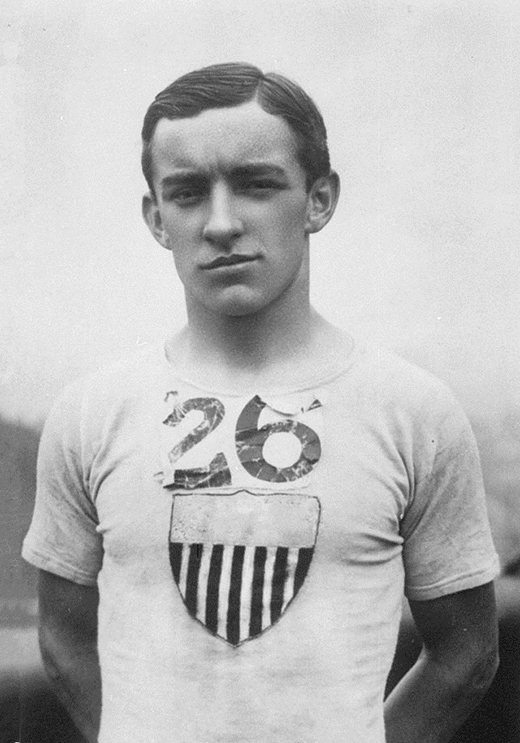
About halfway through the marathon, Hayes began his move. “You’re going too fast, Johnny,” warned Ryan. “No, we’ve got to move now. Stick with me, Mike,” replied Hayes. Ryan did for a while but the hard pace that Hayes was now setting soon caused Ryan to fall back. One by one, Hayes passed the runners in front until the leaders came within sight.
By the 24th mile, it was a three-man race. Charles Hefferon, an Irishman from South Africa, was in the lead, and Dorando Pietri, a diminutive Italian who made Hayes look big, was second. Spectators ran onto the course and slapped Hefferon on the back. He wasn’t English, of course, but he was the next best thing: a British subject. Hefferon accepted a drink from one of the spectators. It was his first and last mistake of the race. Within a mile he developed stomach cramps and slowed dramatically. After a steep climb near Wormwood Scrubs prison, Pietri passed him. Meanwhile, very fresh and strong, Hayes was closing rapidly on both of them. As the Olympic stadium at Shepherd’s Bush came into view, Hayes, at 22 the youngest man in the race, easily pasted Hefferon, the oldest at 30. There was something ironic about the moment: two Gaels from opposite ends of the earth meeting in London. No words were exchanged between the two runners at the time but Hayes later said: “I found out later that Hefferon was of Irish descent. If I had known, I would have talked to him.”
Hayes now set his sights on Pietri, some 50 seconds ahead and about to enter the stadium. It looked as if Hayes would have to settle for second. But as Pietri turned into the stadium with only 385 yards to go, he staggered and suddenly appeared delirious. In the vernacular of marathoners, he had “hit the wall.” When he wobbled off in the wrong direction, British officials turned him around. He took a few steps and collapsed. The officials again came to his aid, lifting him to his feet, and helped him on his way. Again he collapsed and again he was lifted to his feet.
To the dismay of the British spectators, John J. Hayes himself now entered the stadium. The officials redoubled their efforts in aiding Pietri, encouraging, lifting, dragging, and pushing the tough little confection maker from Capri towards the finish.
“He staggered along the cinder path like a man in a dream,” said a reporter on the scene, “his gait being neither a walk nor a run, but simply a flounder, with arms shaking and legs tottering.”
Just short of the finish Pietri started to collapse for the fifth time. Jack Andrews, the chief British official, grabbed him and carried him across the line, some 30 seconds ahead of Hayes. The assistance the officials gave to Pietri was a clear violation of the rules. Nevertheless, the British immediately raised the Italian flag and announced Pietri the victor. Pietri didn’t know or care. He was carried away on a stretcher, delirious and evidently near death.
Meanwhile, Hayes finished strongly, the heat and humidity not seeming to affect him. “Heat never bothers me,” said Hayes later. “My grandfather and father were bakers, and I worked in the bakery as a boy. I was used to the heat.” Nor did the sight of the Italian flag disturb him. “I knew it was going to be all right,” he said. “They had to disqualify Dorando.” Actually, they tried not to. It took several hours and a formal protest from the United States before the British admitted that Pietri had been illegally aided and was, therefore, disqualified.
That night, Johnny Hayes and James Brendan Connolly sat in a London hotel sipping beers until 2:00 a.m. The product of a South Boston Irish family from the Aran Islands in County Galway, Connolly was an Olympic champion himself – the first champion of the modern Olympic Games. He won the first event – the hop, step and jump – of the 1896 Olympics at Athens. He also took third in the broad jump. He later went on to write 25 novels and some 200 short stories.
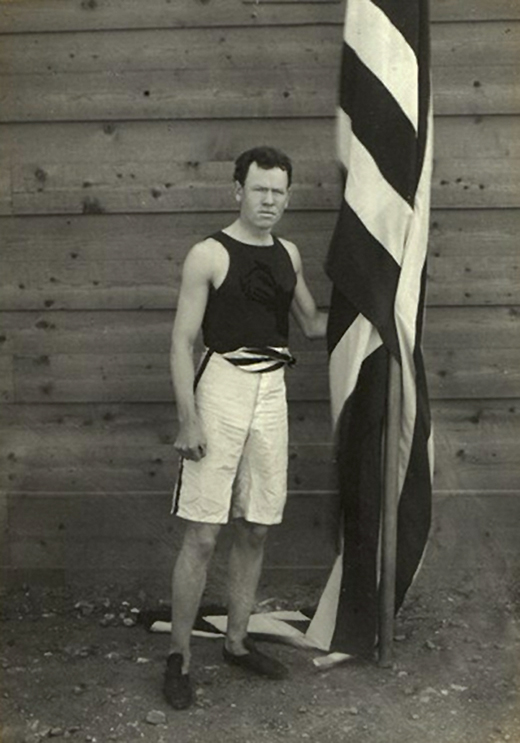
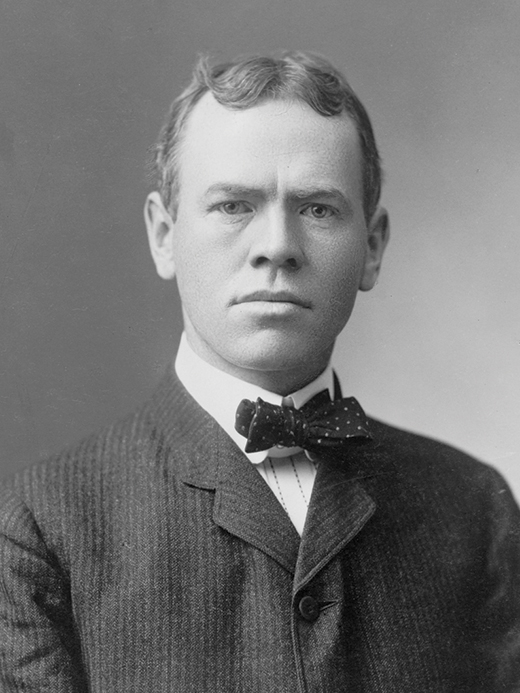
The next day Hayes and Connolly saw another Irishman, Timothy J. Ahern, win Connolly’s favorite event. Ahern set an Olympic record in winning the hop, step, and jump, but his mark was a foot shy of Daniel Shanahan’s world record. Since Ahern was from Ireland, his victory was chalked up in the British column. Americans then swept the high hurdles, and Mel Sheppard, running anchor, led the American team to victory in the 1,600-meter relay race, the final event of the games.
Of the 23 individual championships in track and field, Americans won 13; of those, members of the Irish American Athletic Club of New York City won eight. Britain won seven individual championships, but Irishmen, Robert Kerr of Canada and Timothy Ahern of Ireland, won two of those and a South African won another. Englishmen accounted for exactly four victories, and one of those was Wyndham Halswelle’s solo run in the 400 meters, another two came in walking events in which the English were virtually the only participants.
The crushing American victory in track and field was especially satisfying considering the inhospitable treatment the Americans had received. Said high-jump champion Harry Porter, “In nearly every event the boys had to compete not only against their competitors but against prejudiced judges. The judges may not have been intentionally unfair, but they could not control their feelings, which were antagonistic to the Americans. This was especially true in the field events, where the boys came in closer contact with the judges. The Americans were continually nagged at and made uncomfortable. The officials were discourteous to our men and further, by their encouragement of the other men, tried to beat us.”
While acting mayor Patrick F. McGowan of New York City and Patrick J. Conway, the president of the Irish American Athletic Club, were formulating plans for “an immense civil parade” to honor the American team, the athletes boarded ships for the voyage home. The Irishmen on the team had a stop to make, though. On July 30 they arrived in Dublin and were greeted like conquering heroes. “The greeting accorded them,” reported a correspondent for the New York Times, “was all the more remarkable because it was entirely spontaneous, the mere announcement of the hour of their arrival bringing many thousands of persons to the station to meet the athletes. The streets along the route to their hotel were completely blocked by Dublinites, and the enthusiasm displayed recalled the triumphant entries into the city of Parnell when he was at the height of his popularity.” ♦

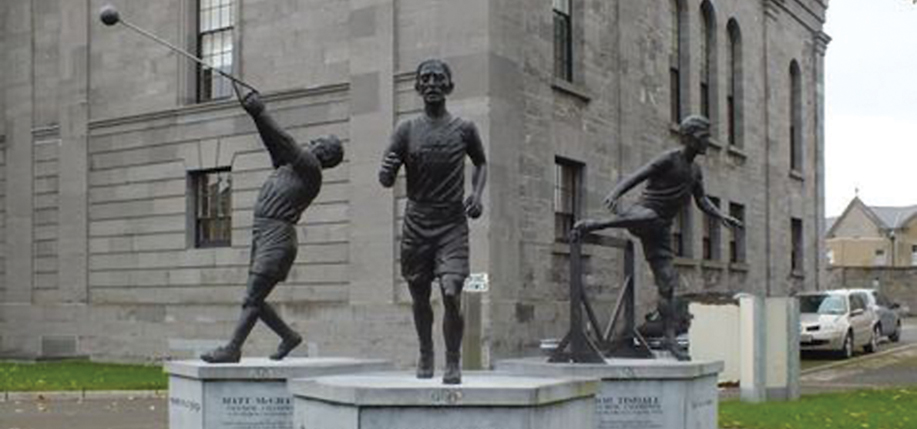
A great article, well done – amazingly, you’re actually missing a few more Irish athletes who won medals in 1908! By our reckoning the Irish won medals in 27 events! 🙂 We are trying to bring these to life close to home through the Irish Sports Museum, which you can follow on social media on Facebook, Twitter and Instagram.
I agree.
My great grandfather, George Guthrie Cameron, medaled twice in the 1908 Olympics. He was a cyclist.
I should clarify that my great grandfather immigrated to the United States from Scotland and cycled for the Irish- American team.
My great grandfather, George Guthrie Cameron, won two medals in the 1908 Olympics.
He immigrated from Scotland to the United States and cycled with the Irish-American team.